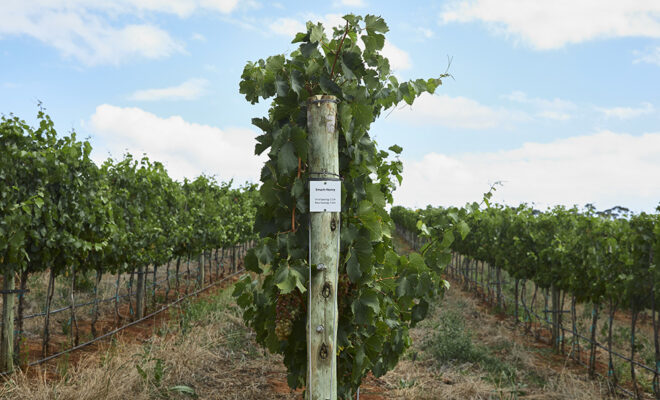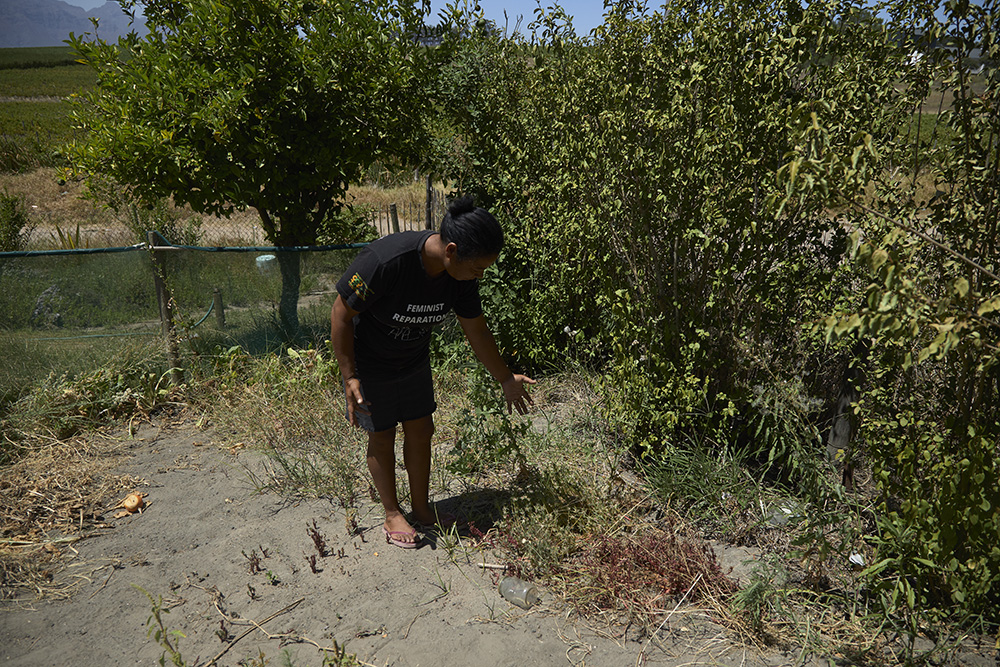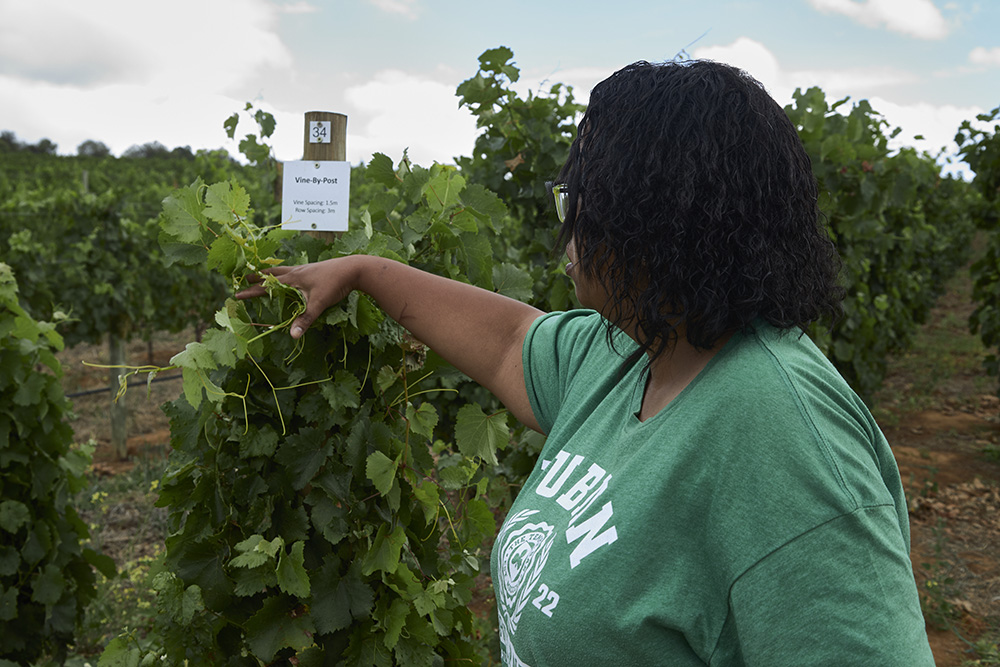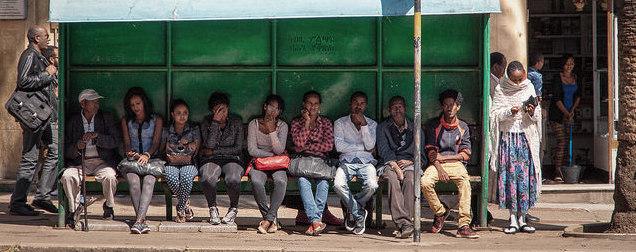Farmworkers feel heat as SA wine industry eyes climate change

As vineyards strategise to keep the famous export flowing, farmworkers – seven of whom died recently of heat stroke – fear more extreme conditions.

A grapevine trellis at Welgevallen Experimental Farm, which is owned by Stellenbosch University and hosts a variety of experiments for its Faculty of AgriScience, Western Cape, South Africa. Photograph: Chris de Beer-Procter
It’s a swelteringly hot summer’s day in Stellenbosch, one of South Africa’s most significant wine-growing regions. Temperatures are in the mid- to high-30s Celsius at 3pm, as farmworkers start making their way home.
According to Charmaine King, 42, this intense heat is not normal. She has been working in Stellenbosch’s vineyards for 15 years and has noticed it getting hotter and harder to work over time. “Sometimes it’s so difficult in the sun,” she says. “When you come home, you are very tired. You are getting a headache from the sun.”
King is one of around 300,000 people directly and indirectly employed by South Africa’s world-famous wine industry. She and her husband rely on the commercial vineyards for their livelihoods and, like many, are increasingly concerned about the effects of climate change on a sector that contributed $3 billion to the economy in 2019.
As global temperatures rise, scientists predict southern Africa will experience less rain and more severe droughts. South Africa’s two major grape-growing regions, the Western and Northern Cape, have already seen a gradual increase in temperatures and falling average rainfall. Although the 2021/22 season was mercifully cooler than normal, the wine industry is still reeling from the effects of a drought from 2016 to 2019, in which Western Cape residents experienced severe water shortages and awaited so-called “Day Zero”.

Farmworker and activist Charmaine King shows her dehydrated home vegetable garden near her home in Stellenbosch, Western Cape, South Africa. Photograph: Chris de Beer-Procter.
As the effects of climate change worsen, all industries will have to adapt, but the challenges for a sector that relies on precise climatic conditions are uniquely complex. Wine-growing regions are carefully chosen for their particular combination of elevation, climate, and geography, and disruptions to these can have significant knock-on effects. Unusual weather patterns can lead to damage from sunburn, frost, and hail, increases in pests and diseases, and plant stress due to drought. These conditions all impact the development and yield of the grapevines, which, in turn, affects the colour, consistency, and flavour of the wine.
Dr Erna Blancquaert is a viticulturist from Stellenbosch University. As the principal investigator on a trilateral research project with China, Belgium, and South Africa – three relatively new wine-producing countries – she has been examining the impact of climate change on chardonnay and pinot. She has been measuring the development of grapevines in South Africa and examining how they perform under different temperatures and climates in the past couple of years.
“We are seeing lots of drought conditions so the plants are definitely more stressed, which can lead to early flowering,” she explains. “We had hail and thunderstorms, which is very unusual. That of course had numerous implications. Rain during the active green growing stage results in very high fungal pressure.”
Blancquaert emphasises the delicate balance of natural forces that need to come together every season. “If you get rain during flowering, you will get poor fruit set, which can produce smaller seedless grapes. If you get rain or too much wind, pollination can’t happen,” she says. “The key thing with climate change is that it impacts the fruit quality.”

Dr Erna Blancquaert shows various trellis systems at Welgevallen Experimental Farm. Blancquaert is the first black woman to receive a PhD in viticulture in South Africa. Photograph: Chris de Beer-Procter
In the face of these changes, wine producers are adapting. Tackling some challenges is more straightforward. For instance, several vineyards are starting to put up nets to protect the plants from hail damage. Growers are also becoming more alert to the less predictable timing of different stages of the season and adjusting accordingly. Drought-induced early flowering can mean harvesting needs to happen sooner than usual, while unusually prolonged cold wet weather – as experienced in 2021/22 – can lead to delayed flowering and ripening. Tracking grapevines’ development and being responsive has become essential.
Other difficulties, however, can be harder to mitigate. Stephanie Midgely, a Climate Change Specialist in the Western Cape Department of Agriculture, notes how the problems caused by – and necessary solutions to – less rainfall are multi-faceted. “[Among other things], an essential part of this aspect is an increased effort to control and reduce the infestations of invasive alien plants in our catchments that use a significant amount of water,” she says.
Midgely emphasises the “multiple stresses” – including issues like South Africa’s electricity crisis – facing South Africa’s wine industry, of which climate change is just one. To respond to these, she says the Western Cape Department of Agriculture is implementing the SmartAgri plan, led by stakeholders in the sector. The plan officially started in 2016 as a response to the climate crisis.
“We have excellent strategies and tools/technologies, together with strong human and social capital, to drive innovation and adaptation,” she says. “If we can harness these strengths and respond with greater urgency we should be able to protect and grow the wine industry and agriculture into the future.”
Conrad Schutte, Consultant Director at Vinpro, a non-profit organisation that represents wine producers, is similarly hopeful. He agrees that climate change is a concern for wine-growers across the world but believes South Africa is leading the way in terms of mitigation strategies. “Producers [in South Africa] are very innovative in finding solutions to problems,” he says.
Schutte notes that South Africa is home to several research projects, including into the drought tolerance of 17 different grape varieties, as well as demonstration sites and expertise on climate change adaptation from the vineyard to the cellar. For him, the biggest challenge will be to find ways to move water to where it is needed – or, perhaps, to move vineyards to where new climatic conditions are more favourable.
“On the whole, South Africa should still be able to export as international markets demand,” he says. “[But] we might see shifts in between the regions which might become better or worse suited to grow specific wine styles.”

A grapevine in Stellenbosch, Western Cape, South Africa. Photograph: Chris de Beer-Procter
While some experts are optimistic that South Africa’s wine industry can adapt to climate change, others are concerned about the effects on workers. Farm workers are already economically marginalised, earn low wages, and rely on seasonal work. As temperatures rise, they will be expected to work under increasingly precarious and harsh conditions as crops ripen quicker in the extreme heat. In what may be a worrying sign of things to come, seven farm workers died of heat stroke this January in the Northern Cape.
For Carmen Louw, Co-Director for the Women on Farms Project, a feminist organisation that works with female farmworkers, these avoidable deaths are an indictment of the way commercial agriculture in South Africa puts profits before human life, regardless of climate change. “It’s all about financial gain for a small group,” she says.
In the wake of the deaths, officials urged farm managers to ensure workers are given adequate water refreshments and breaks. Louw, however, insists that we see the difficulties facing farmworkers are part of a much bigger structural problem – namely, that more land is being given over to a small number of large commercial landowners. These big agribusinesses typically engage in farming that requires high inputs of chemicals, water, and energy. This model is not only economically unsustainable for disempowered, landless, and lowly-paid seasonal workers but is also highly carbon emitting.
“Our vision is that there must be agrarian transformation, where there is a different type of agriculture that is not as dependent on chemicals, water, and energy,” says Louw. She explains that if more farmers owned land, the result would be both more economically equitable and, given the lower demands of smaller farms, would reduce the need for environmentally damaging chemical inputs and machinery. “It’s part of our just transition,” she adds.
This critique speaks to the challenges faced by farmworkers like King. After 15 years working in the billion-dollar wine industry, she remains economically vulnerable. Her and her husband’s wages from working in the vineyard have not provided them any economic security. These days, they struggle to afford to even travel into Stellenbosch to buy food – a task that has become necessary as their vegetable garden has failed amid the heat and drought. This is another example of how the climate crisis is hitting the poorest hardest and in multiple conjoined ways.
“My vegetable garden was one of the biggest helps financially,” says King. “The money we earn is not enough, and now we must use that money to pay for transport. There are other things that we must pay for. Then we have nothing.”
Text by Matthew Hirsch. Photographs by Chris de Beer-Procter.






